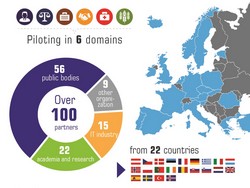The building blocks for digital governments' revolution
The basic digital infrastructure building blocks are now available to public administrations and service providers, enabling them to develop their own online services without the need for having to first develop their own technical solutions. Several service providers – including giants like IBM as well as innovative SMEs – are using these building blocks to develop their own software solutions for Member States, public services and organisations. In this way, a new e-services market has been created, and the feedback from end users has been positive from users across all domains. Digitally connecting Europe ‘Digital services vary across Europe, resulting in a number of barriers when it comes to cross-border transactions,’ explains e-SENS project coordinator Carsten Schmidt from the Ministry of Justice of North Rhine-Westphalia, Germany. ‘Previous projects have tended to address this issue by focusing on just one domain such as delivering e-health, mobility or judicial services. The aim of e-SENS has been to bring together the results of these individual initiatives, break up silos and deliver building blocks that can be used to develop solutions across a range of sectors.’ Between April 2015 and March 2017, some 65 pilots across 18 countries were deployed to prove that seamless e-ID could be implemented, using the results of previous pilot projects (like STORK, PEPPOL, SPOCS, ePSOS and e-CODEX) that successfully created Connecting Europe Facility (CEF) technical building blocks for e-ID and document delivery, to name but a few tools. Administrative procedures such as accessing health services, starting a business abroad and bidding for contracts in another country were conducted between countries electronically. With this in mind, creating comprehensive Digital Service Infrastructures (DSIs) offers the prospect of an investment well made. Just boosting online cross-border access to patient summaries will save more than EUR 36 million, according to one study. ‘These are just a few examples of the large benefits that can be obtained,’ says Carsten Schmidt. Meeting EU standards Another key advantage is that public administrations and service providers using e-SENS building blocks for developing e-delivery solutions will be putting infrastructure in place that fulfils the technical requirements of the EU electronic identification and trust services (eIDAS) regulation. This is an important consideration; during the Commission’s preparation of eIDAS, the need to put in place an electronic identification that is user-friendly, trustworthy and applicable in different countries for exchanging documentation was highlighted as a key need by public administrations. Furthermore, the achievements of e-SENS will feed into full scale deployment of services funded through CEF, which is investing some EUR 970 million in digital service infrastructures over 7 years. This will deliver connected cross-border services for citizens, businesses and public administrations, and represents a significant step forward in creating the Digital Single Market in Europe. ‘The e-SENS consortium has been in constant contact with organisations like standardisation bodies, civil law groups and commercial networks in order to provide them with information about these technical building blocks and project outcomes,’ says Carsten Schmidt. ‘We now want to help them to make use of these tools in their own projects.’
Keywords
E-SENS, CEF, digital, infrastructure, public services, STORK, PEPPOL, SPOCS, E-CODEX



